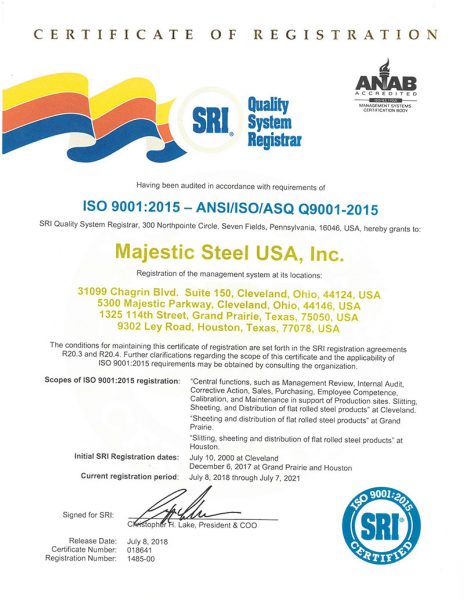Market Update | October 18, 2023
INDUSTRIAL PRODUCTION INCREASED IN SEPTEMBER
Manufacturing output increased 0.4% after slipping slightly in August but was still 0.8% below the level of a year ago. Within manufacturing, motor vehicles and parts were up only 0.3% due to the ongoing strike at the Big Three. Elsewhere, wood products, primary metals and plastic and rubber production manufacturing all increased 1.0%.
Input Costs
After a holding steady last week, zinc pricing slipped this week as buying activity remained subdued following the week-long Chinese holiday.
- Zinc pricing slipped to $1.10/lb this week but has remained in a relatively tight range for the past month.
- The average over the past 30 days is $1.13/lb.
Met coal pricing continued to push higher this week, climbing to $366/mt on the increased demand and tight supply.
- This is up 0.8% from last week and is up 16.3% from this time last month.
Supply
U.S. raw steel production slipped again this week, now down for the third straight week.
- U.S. steelmakers produced 1.695 million tons at a 73.8% utilization rate.
- This is the lowest weekly utilization rate since the last week of January.
- The current YTD utilization rate is at 75.9%, down 1.1% compared to the same time last year.
A five-month high in order rates helped push carbon flat rolled inventories higher in September.
- The bottoming of pricing combined with recent excessive leaning out of inventory helped spur buying activity.
- The increase on order tonnage helped to overcome a three-month high daily shipment rate.
- The increase on order tonnage helped to overcome a three-month high daily shipment rate.
Based on preliminary import licenses for October (16 days), total steel imports are down 2.9% compared to the daily pace in September.
DEMAND
Business activity in the manufacturing sector in the New York region declined in October after expanding in September.
- The October Empire Manufacturing Index came in at -4.6, down from 1.9 in September.
- Any reading below 0.0 denotes contraction, while any reading above 0.0 shows expansion.
- While the new order component slipped back into contraction, the shipment component grew at a much slower rate than in September.
- The new order and shipment components came in at -4.2 and 1.4, respectively.
- The unfilled orders component declined sharply, sliding to -19.1 from -5.2.
Industrial production increased in September, climbing 0.3% from August.
- Manufacturing output increased 0.4% after slipping slightly in August but was still 0.8% below the level of a year ago.
- Within manufacturing, motor vehicles and parts were up only 0.3% due to the ongoing strike at the Big Three.
- Elsewhere, wood products, primary metals and plastic and rubber production manufacturing all increased 1.0%.
- Overall capacity utilization increased to 79.7%, right at the fifty-year average.
- The capacity utilization for manufacturing increased by 0.1% in September, climbing to 77.8 %.
- The current rate is still 0.4% below the long-run average.
New residential construction increased sharply in September after seeing a steep decline in August.
- September new housing starts came in at a 1.358 million unit rate, up 7.0% from August but still down 7.2% from the 1.463 million unit rate in September 2022.
- This is the second consecutive year-over-year decline for new starts.
- The boost in new starts in September came from both single-family and multi-family units.
- Year-to-date actual starts are still down 12.1% from the same timeframe last year.
- Permits for new construction, a leading indicator for starts, declined after climbing the previous two months.
- New permits came in at a 1.473 million unit rate, down 4.4% from August and down 7.2% from September 2022.
ECONOMIC
Retail sales for September continued to push higher, climbing 0.7% to $704.9 billion.
- Prices continued to climb sharply on a year-over-year basis as well, climbing 3.8% from the $679.4 billion rate in September 2022.
- Excluding motor vehicles and parts, sales were up 0.6% from September and up 3.2% from September 2022.
- The largest increases in sales in September came from gas stations, auto dealers, health & personal care stores, and online retailers.
- These increases helped to overcome declines from clothing stores, building material stores, and electronic stores.
- YTD retail sales are now up 3.1% compared to the first nine months of 2022.
- Excluding motor vehicle dealer and gasoline station sales, YTD sales are up 5.0% from last year
While it is off to a muted start to the peak season for freight, the market is looking to have savings this holiday season.
- Overall inferred freight rates declined 1.9% from August and were down a sharp 20.4% compared to September 2022.
- While the Cass shipment component saw a strong 1.7% increase from August, the expenditure component slipped 0.2%.
- Within the freight rates, the truckload rates increased 0.5% in September.
- This slight increase in September is more likely a pause in declining rates rather than a change in trend.
- This, however, might be a sign that truckload rates are nearing a bottom.
- The market continues to expect freight rates to turn higher once capacity tightens, but early signs of 2024 equipment production suggest that may take some time
This material, information and analyses (the “Content”) may include certain statements, estimates and projections prepared with respect to, among other things, historical data and anticipated performance. Content may reflect various assumptions by Majestic Steel USA, Inc. concerning anticipated results that are inherently subject to significant economic, competitive and other uncertainties and contingencies and have been included for illustrative purposes. Content is provided AS-IS.

